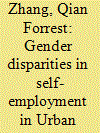| Srl | Item |
| 1 |
ID:
124651


|
|
|
|
|
| Publication |
2013.
|
| Summary/Abstract |
This article presents the first quantitative analysis of gender disparities in self-employment in urban China. It documents the extent of gender income inequality in self-employment. By disaggregating self-employment into three occupational classes, it reveals the gender segregation within self-employment - women were concentrated in the financially least rewarding segment - and identifies it as a main source of gender income inequality. I examine a range of determinants of participation in self-employment, including family structure, family background and career history, and how their gender-specific effects contribute to gender segregation. Although using data from a 1996 national survey, this study captures two key processes that shaped the structure of self-employment in contemporary urban China: the restructuring of the state sector and the growth of financial returns and social status in the private sector, both of which contributed to the formation of gender segregation in self-employment.
|
|
|
|
|
|
|
|
|
|
|
|
|
|
|
|
| 2 |
ID:
148228


|
|
|
|
|
| Summary/Abstract |
Gender segregation in the public domain has become a cornerstone of the Saudi interpretation of Islam (Doumato 2009). It is a development that has led to the coming about of extensive separate public spaces that are only for women (Doumato 2009; Hamdan 2005; Le Renard 2008, 2014). In these women-only public spaces, women undertake activities that are by them and for them, therewith reinforcing the existence of these separate structures. This institutionalisation and practice of women-only public spaces, as well as its opposite phenomenon of ‘mixing’ between the two sexes (ikhtilāṭ) however is contested and led to a heated debate. This debate centres around the question of whether and if so, how women should participate in the public domain. Starting with an overview of the historical development of women-only public spaces and ikhtilāṭ in Saudi Arabia, I will show how these have evolved. Drawing on fieldwork among urban, educated Saudi women, I shed light on how attitudes and strategies of female respondents regarding women-only public spaces and ikhtilāṭ are related to their ideas about their presence in the public domain and notions of ‘the liberation of women’, ‘empowerment’, and ‘the rise of women’. I conclude by demonstrating how ideas about the participation of women in the public sphere are positioned as part of the construction of a local, ‘enchanted’ modernity (Deeb, 2006) that has a material and a spiritual dimension.
|
|
|
|
|
|
|
|
|
|
|
|
|
|
|
|